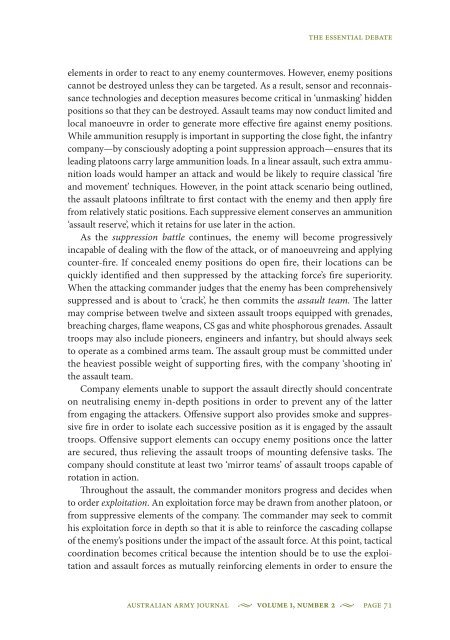The Essential Debate: Combined Arms and the ... - Australian Army
The Essential Debate: Combined Arms and the ... - Australian Army
The Essential Debate: Combined Arms and the ... - Australian Army
You also want an ePaper? Increase the reach of your titles
YUMPU automatically turns print PDFs into web optimized ePapers that Google loves.
<strong>The</strong> <strong>Essential</strong> <strong>Debate</strong>elements in order to react to any enemy countermoves. However, enemy positionscannot be destroyed unless <strong>the</strong>y can be targeted. As a result, sensor <strong>and</strong> reconnaissancetechnologies <strong>and</strong> deception measures become critical in ‘unmasking’ hiddenpositions so that <strong>the</strong>y can be destroyed. Assault teams may now conduct limited <strong>and</strong>local manoeuvre in order to generate more effective fire against enemy positions.While ammunition resupply is important in supporting <strong>the</strong> close fight, <strong>the</strong> infantrycompany—by consciously adopting a point suppression approach—ensures that itsleading platoons carry large ammunition loads. In a linear assault, such extra ammunitionloads would hamper an attack <strong>and</strong> would be likely to require classical ‘fire<strong>and</strong> movement’ techniques. However, in <strong>the</strong> point attack scenario being outlined,<strong>the</strong> assault platoons infiltrate to first contact with <strong>the</strong> enemy <strong>and</strong> <strong>the</strong>n apply firefrom relatively static positions. Each suppressive element conserves an ammunition‘assault reserve’, which it retains for use later in <strong>the</strong> action.As <strong>the</strong> suppression battle continues, <strong>the</strong> enemy will become progressivelyincapable of dealing with <strong>the</strong> flow of <strong>the</strong> attack, or of manoeuvreing <strong>and</strong> applyingcounter-fire. If concealed enemy positions do open fire, <strong>the</strong>ir locations can bequickly identified <strong>and</strong> <strong>the</strong>n suppressed by <strong>the</strong> attacking force’s fire superiority.When <strong>the</strong> attacking comm<strong>and</strong>er judges that <strong>the</strong> enemy has been comprehensivelysuppressed <strong>and</strong> is about to ‘crack’, he <strong>the</strong>n commits <strong>the</strong> assault team. <strong>The</strong> lattermay comprise between twelve <strong>and</strong> sixteen assault troops equipped with grenades,breaching charges, flame weapons, CS gas <strong>and</strong> white phosphorous grenades. Assaulttroops may also include pioneers, engineers <strong>and</strong> infantry, but should always seekto operate as a combined arms team. <strong>The</strong> assault group must be committed under<strong>the</strong> heaviest possible weight of supporting fires, with <strong>the</strong> company ‘shooting in’<strong>the</strong> assault team.Company elements unable to support <strong>the</strong> assault directly should concentrateon neutralising enemy in-depth positions in order to prevent any of <strong>the</strong> latterfrom engaging <strong>the</strong> attackers. Offensive support also provides smoke <strong>and</strong> suppressivefire in order to isolate each successive position as it is engaged by <strong>the</strong> assaulttroops. Offensive support elements can occupy enemy positions once <strong>the</strong> latterare secured, thus relieving <strong>the</strong> assault troops of mounting defensive tasks. <strong>The</strong>company should constitute at least two ‘mirror teams’ of assault troops capable ofrotation in action.Throughout <strong>the</strong> assault, <strong>the</strong> comm<strong>and</strong>er monitors progress <strong>and</strong> decides whento order exploitation. An exploitation force may be drawn from ano<strong>the</strong>r platoon, orfrom suppressive elements of <strong>the</strong> company. <strong>The</strong> comm<strong>and</strong>er may seek to commithis exploitation force in depth so that it is able to reinforce <strong>the</strong> cascading collapseof <strong>the</strong> enemy’s positions under <strong>the</strong> impact of <strong>the</strong> assault force. At this point, tacticalcoordination becomes critical because <strong>the</strong> intention should be to use <strong>the</strong> exploitation<strong>and</strong> assault forces as mutually reinforcing elements in order to ensure <strong>the</strong><strong>Australian</strong> <strong>Army</strong> Journal Volume I, Number 2 page 71
















